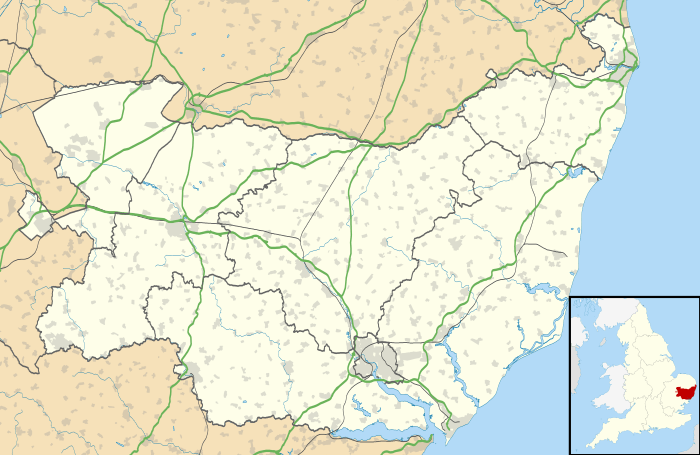Thurston, Suffolk
| Thurston | |
| Thurston village sign |
|
 Thurston |
|
| Population | 3,232 (2011 Census) |
|---|---|
| OS grid reference | TL929650 |
| District | Mid Suffolk |
| Shire county | Suffolk |
| Region | East |
| Country | England |
| Sovereign state | United Kingdom |
| Post town | BURY ST EDMUNDS |
| Postcode district | IP31 |
| Dialling code | 01359 |
| Police | Suffolk |
| Fire | Suffolk |
| Ambulance | East of England |
| EU Parliament | East of England |
| UK Parliament | Bury St Edmunds |
Coordinates: 52°15′00″N 0°49′33″E / 52.24994°N 0.8259°E
Thurston is a village and a parish in Suffolk situated about 4 miles (6 km) east of Bury St Edmunds and 10 miles (16 km) west of Stowmarket.
In mid-2005, Thurston's estimated population was 3,260, making it one of the larger communities in the area,[1] falling slightly to 3,232 at the 2011 Census.[2]
Thurston railway station opened in 1846 and is still operating today. The village also has frequent bus service to neighbouring towns, including Bury St Edmunds. The village is located under 2 miles (3 km) from the A14 and under 40 miles (64 km) from the M11 motorway.
History
The village is recorded in the Domesday Book as having a population of 66 households. It was part of the lands of the Abbey of Bury St Edmunds, then one of the largest landlords in England.[3][4]
By the 1870s, the village had grown substantially. It is mentioned in John Marius Wilson's Imperial Gazetteer of England and Wales as a community with 2,200 acres of land, a population of 740 and 157 households.[5] The village's farming past is reflected in its listed buildings, which include several former farmhouses and associated farm buildings.[6]

St. Peter's Church is at the geographical centre of the village and has services every Sunday at 10.30 am. The original church was Medieval, but was largely rebuilt in 1861 after a dramatic collapse of the tower onto the nave the night before major renovations were due to begin. Its architect was John Henry Hakewill (son of the distinguished architect Henry Hakewill), and rebuilding took 18 months and cost around £3,500. Some 14th and 15th-century features, including the font, chancel windows and vestry were retrieved and reinstated in the Victorian church.[5][7]
The church is Grade II listed.[8] The church's ring of five bells was augmented to six, after a donation of a bell from St Albans Abbey by the charity the Keltek Trust in 2012.[9]
Thurston also has a small Methodist church in Church Road, which also conducts regular services.[10]
The original village hall, still known as The Cavendish Hall, was gifted (both land and building costs) to Thurston in 1913 by Julia Florence Cavendish, the American-born wife of Tyrell William Cavendish, who lost his life on the Titanic. The couple had joined the ship's maiden voyage to New York to see Julia Cavendish's father Henry Siegel shortly after purchasing Thurston House, which they were renovating. After Tyrell's death, Julia asked the Parish Council if the Hall could be built as his memorial, but sold Thurston Hall without living in it.[11][12][13]
Village amenities
In addition to Cavendish Hall, Thurston has a second hall, known as the New Green Centre, which opened in 1991. It is set in parkland and operates as a venue for village sports activities, clubs, meetings and events. Other activities in the village include an Air Training Corps squadron.[14]
The village has two pubs, The Victoria on Norton Road and The Fox and Hounds on Barton Road, near the railway line.[15] There is also a bar at the Grange Hotel (formerly known as Thurston Grange), a mock Tudor hotel with banqueting and conference facilities.[16]
There is a small business park, known as Thurston Granary, located in the village and other businesses include Harvey's Garden Plants, a family-run garden centre/tea room that has won Gold Medals at Chelsea.[17]
The local public upper school is Thurston Community College, with about 1,500 pupils from the village and surrounding communities. The school also has a sixth form, with 400–500 students, and a primary school.
References
- ↑ "Estimates of total population of areas in Suffolk" (PDF). Suffolk County Council. Retrieved 31 July 2008.
- ↑ "Civil Parish 2011". Neighbourhood Statistics. Office for National Statistics. Retrieved 29 August 2016.
- ↑ "Thurston | Domesday Book". Domesdaymap.co.uk. Retrieved 13 May 2013.
- ↑ "St Edmundsbury Local History – The Little Domesday Book". Stedmundsburychronicle.co.uk. 22 April 2010. Retrieved 13 May 2013.
- 1 2 "History of Thurston in Mid Suffolk | Map and description". Visionofbritain.org.uk. Retrieved 13 May 2013.
- ↑ Good Stuff IT Services. "Listed Buildings in Thurston, Suffolk, England". British Listed Buildings. Retrieved 13 May 2013.
- ↑ "Suffolk Churches". Suffolk Churches. Retrieved 13 May 2013.
- ↑ Good Stuff IT Services. "Church of St Peter – Thurston – Suffolk – England". British Listed Buildings. Retrieved 13 May 2013.
- ↑ David Kelly. "Thurston, Suffolk". Keltektrust.org.uk. Retrieved 13 May 2013.
- ↑ "Thurston – East Anglia District". Eamethodist.org.uk. Retrieved 14 May 2013.
- ↑ "History". Thurston-village.co.uk. Retrieved 14 May 2013.
- ↑ "Cavendish Children Escape :: New York Times". Encyclopedia-titanica.org. 23 April 1912. Retrieved 14 May 2013.
- ↑ "Suffolk Connections to the Titanic". GB: Hartest.onesuffolk.net. Retrieved 14 May 2013.
- ↑ "863 Thurston Squadron". 863sqn.org.uk. 26 December 2011. Retrieved 13 May 2013.
- ↑ "Thurston summary from". Suffolk Camra. Retrieved 14 May 2013.
- ↑ "Eating out: The Grange Hotel, Thurston". EADT Suffolk Magazine. Retrieved 7 March 2015.
- ↑ "15. Harvey's Garden Plants "The Orchard Room at the heart of the nursery is". The Independent. 9 March 2012. Retrieved 14 May 2013.
External sources
External links
![]() Media related to Thurston, Suffolk at Wikimedia Commons
Media related to Thurston, Suffolk at Wikimedia Commons